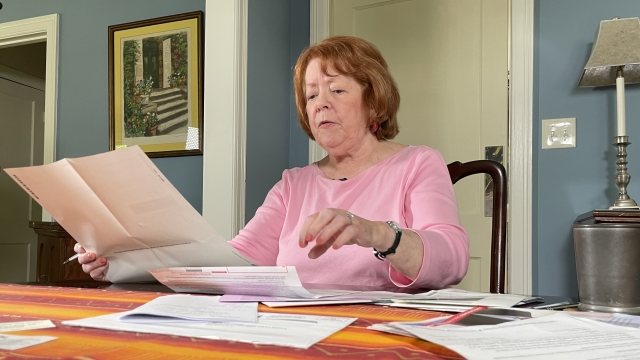Small changes in new voting rules for something as simple as an envelope. Sealing it can keep legitimate votes from counting. That's the takeaway from Newsy's investigation into what happened with a surge of rejected ballots in Texas.
We found a redesigned ballot envelope, which Republicans in Texas said would prevent voter fraud, actually blocked legal votes, including one from Rev. Aroyal Ruth Princess-Love.
"I was shocked," she said.
Princess-Love hadn't missed an election in decades. She even volunteers at the polls.
"I mean, it's just it's part of my breathing, voting is," she said. "It's just part of my nature."
Princess-Love is among Texans who failed to comply with a new rule for voters to print their driver's license number, or last four digits of their social security number, on their ballot return envelope.
Princess-Love told Newsy she just never saw the new instructions.
The rate of rejected mail-in ballots in Texas jumped from less than 1% in 2020, to more than 12% during a March primary.
The state doesn't track how often the new ID rule on the envelope was the problem, but data we analyzed from Harris County — home to Houston — gives us a good idea.
Harris County rejected about 7,000 ballots because of the new ID requirement.
It may surprise you to hear the envelope tripped up Republicans at a higher rate than Democrats.
Interviews with denied voters reveal the problem was with the design of the new ballot envelope.
The ID requirement was buried in a heap of fine print.
"I had not read that, and probably most of Houston hadn't read that," Republican voter Susan Gaertner said.
It appears the key instructions were printed in about 7-point font, even though national election standards recommend nothing smaller than 10-point font.
Also, the boxes for voters to fill out ID numbers had to be hidden for privacy, according to the secretary of state's office, which designed the envelope.
They were in an unusual place beneath the envelope's flap.
Whitney Quesenbery helps election offices build simple, clear ballots.
"I think design had a huge impact here," she said.
She says the trouble in Texas is a warning to 18 other states that also passed restrictive voting rules after the 2020 election.
Hasty design changes, even to just an envelope, can disenfranchise voters of all political stripes.
"This is not just an envelope," Quesenbery continued. "This is like — this is the pony express of Democracy."
Ohio has a similar requirement for mail-in voters to include an ID number. Yet that state's rejection rates are normal, low. The difference? Ohio's voter instructions have been the same for years.
They're big, written in plain language and important things are highlighted.
"They've numbered the steps," Quesenbery said. "You must complete all five sections, so they've done things to create a pathway through it."
Ohio also has more space to work with, spreading out instructions on a second secrecy envelope.
Quesenbery says Texas just didn't have enough time to thoughtfully re-tool its ballot.
The new law took effect in December, with an election on March 1.
"When we ask elections to move fast, it's easy to make mistakes," she said. "And it's easy to make mistakes, not because someone's trying to make mistakes, but because it's a complicated, human system."
Poor design may have been especially significant in Texas, where mail-in voting is reserved for people with disabilities and seniors.
"Lots of people have old age infirmities, which include your vision going," Quesenbery said.
Harris County Elections Administrator Isabel Longoria said officials had no choice but to cram the new instructions on a mailer with limited space.
"This is very clearly an envelope, right? What makes it so difficult is you see all this text," she said. "It is mandated by law we include it on here, no matter how small the font is, to maintain uniformity of ballots across the state. Even the smallest tweaks need approval."
To make one word purple, Longoria said she had to get approval from the secretary of state and that took about a month.
The Secretary of State's Office acknowledges the ballot envelope was difficult to navigate. An updated envelope now includes red boxes around the ID requirement to draw voters' attention.
But Harris County said it's impractical to switch envelopes now.
They have stacks of the old envelope. Election offices had to buy supplies for 2022 months ago to handle another problem — paper shortage.
"You have to actually plan six months to eight months in advance to even get these things," Longoria said.
They plan to re-evaluate design of the mail ballot envelopes ahead of the November election. Election offices in Texas call up voters who send an incomplete ballot if they have a phone number on file, giving them a chance to fix the problem so their vote can be accepted.
Longoria is concerned rejection rates appear to be high again during May voting, especially among African American voters.
"Texas is no longer a leader when it comes to voting innovation," Longoria said. "In fact, I think we're a warning sign to the rest of the country."
Longoria agreed to resign her post effective July, amid backlash over an unrelated issue involving the unofficial tally of ballots.
Neither Princess-Love nor Gaertner fixed their ballots from March, both deciding to wait until the next election to try again with voting by mail.
"We shouldn't give up on it," Princess-Love said.
Gaertner carefully filled out that tricky ballot envelope for the May election, a little less sure her vote would count.
Newsy is the nation’s only free 24/7 national news network. You can find Newsy using your TV’s digital antenna or stream for free. See all the ways you can watch Newsy here.



